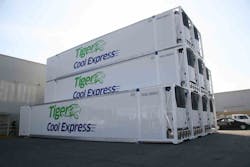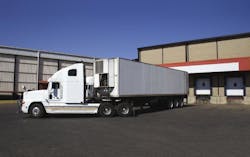Small fleets and own-operators provide a large proportion of the freight transportation capacity for fresh foods and produce shipments. Yet they are also poised to be the two trucking elements hit hardest by the impending electronic logging device (ELD) mandate this December, according to two noted intermodal industry experts.
As a result, the refrigerated transport sector – which is already under strain due to the rise in demand for more “organic” and “ethnic” fresh produce – may witness significant change, according to Tom Finkbiner and Theodore “Ted” Prince, co-founders plus CEO and COO, respectively, of Tiger Cool Express LLC, an intermodal refrigerated carrier.
In a conference call with reporters this week hosted by Stifel Capital Markets, they both noted that ELDs will result in significantly shorter lengths of haul for truckload operations large and small while lengthening time delivery windows.
“Many shippers … figure [truckers] can cover 650 miles per day in the hours available,” Prince explained. “But most [motor] carriers say 450 miles a day is more realistic. Even 200 miles per day is now considered a good number. That means a five-day delivery now becomes a seven-day delivery.”
That’s a concern when shipping fresh produce as every day of delivery represents $1,000 worth in spoilage, noted Finkbiner.
On top of that, one of the reasons there are not more publicly-held/larger motor carriers in the fresh produce freight market is due to the seasonality of the business.
“Peak season for each fruit and vegetable is only six to eight weeks in each location,” he pointed out. “Volume and variability are the key challenges because what you see is about a 70% differential between peak and valley months in [produce] shipping.”
That’s why it’s difficult for larger truck lines in this market, Finkbiner said. “When you are going from 1,000 loads a day of fresh produce out of California up to 7,000 loads per day it is very difficult for even the largest carriers to make that kind of flex.”On top of that, the top two “growth items” in the fresh produce sector –organic and “ethnic” fruits and vegetables – often cannot be grown in large enough quantities at single locations to create full truckload shipments, thus requiring multiple “live loading” stops in order to generate profitable loads.
Both Finkbiner and Prince said that means many of the small fleets and owner-operators routinely bend hours of service (HOS) rules to accommodate the time-consuming “live load and live unload” produce-hauling environment as well as cover the long distances typically involved in moving perishable freight from field to distribution centers and/or stores
“They have a very perishable shelf life, especially for fresh produce: less than 15 days for tree fruit and 15 to 30 days for grapes,” Finkbiner added.
To meet demanding shelf life requirements in the post-ELD environment, small carriers and owner-operators will need large rate increases to cover reduced productivity associated with strict HOS rule compliance or they may exit the industry altogether.
As a result, Stifel believes the potential capacity shortfall in 2018 and beyond “could be dramatic” for this sector if that happens and would also generate a modal shift in freight transport as well.
“Heavy density, long shelf life produce may gravitate towards refrigerated [railroad] boxcars, while lighter density, shorter shelf life produce will remain the domain of team-expedited refrigerated truckload carriers,” the firm noted.
“Medium-density, medium-shelf life freight will likely become the domain of rail intermodal and whatever remains of legal solo-driver truckload capacity,” Stifel added.
About the Author
Sean Kilcarr
Editor in Chief
Sean Kilcarr is a former longtime FleetOwner senior editor who wrote for the publication from 2000 to 2018. He served as editor-in-chief from 2017 to 2018.

